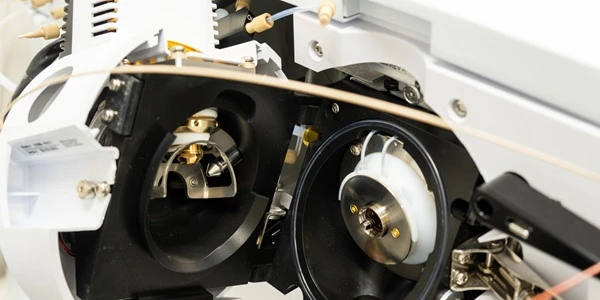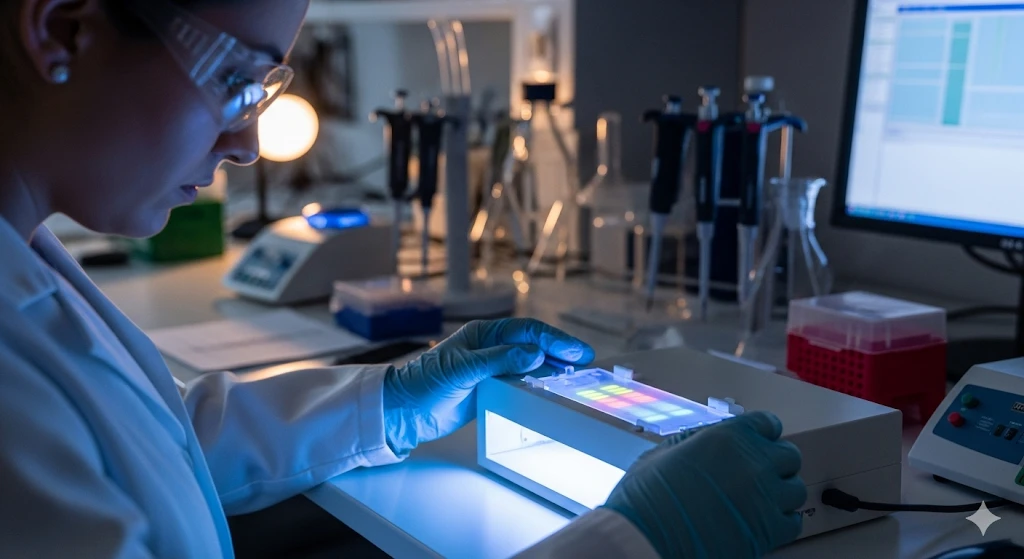Growing Trends in Food Safety and Testing: Interactive Infographic Timeline
The global food and agriculture industries are rapidly expanding. Demands for a wider range of products to feed a growing number of consumers continue to escalate. Along with these demands comes the need for advanced food testing technologies and solutions with which to monitor safety and authenticity.
The Food Safety and Testing Interactive Infographic is a living resource, keeping stride with emerging developments in the fast-moving food and beverage industries.
This post serves as a chronology of the infographic, citing ongoing developments in the areas of: Pesticides and Contaminants Testing, Food Profiling and Authenticity, Food Quality Control, Food Borne Illness and Microbial Testing.
 Pesticides and Contaminants Testing
Pesticides and Contaminants Testing
Pesticides residue analysis
As food safety regulations change, so do restrictions on the use and maximum residues limits (MRLs) of permissible pesticides. High-resolution LC-MS and GC-MS instrumentation coupled with comprehensive compound profiling and discovery solutions are allowing testing labs to stay ahead of the ever-evolving pesticides residues analysis world.
- 4/2020 - Agilent has announced a Virtual Food Summit for discussion of Improved LC-MS/MS Pesticide Multiresidue Analysis, Multi-platform screening approaches for pesticides and food contaminants by GC/MSD, GC/TQ, and GC/Q-TOF, routine food classification and authenticity workflows for high-resolution MS, and more.
- 7/2020 - A modified version of the Quick Polar Pesticides Extraction (QuPPe) method was recently described for extraction and determination of Glyphosate using a compact ion chromatograph coupled with triple quadrupole (QQQ) mass spectrometer (IC-MS/MS).
- 12/20 - SCIEX has reported on "Precise testing of pesticides in food using the SCIEX Triple Quad™ 7500 LC-MS/MS System – QTRAP® Ready" -- an analysis of over 700 compounds covering required testing for numerous regions including Europe, North America and various areas within Asia.
- 5/2021 - Metrohm has made available several resources for food and beverage analytical testing, including "Trace Detection of Carbendazim, a common fungicide approved for regulated use in agriculture, on Strawberries" using MISA - Metrohm Instant SERS Analyzer.
- 12/21 - Restek now offers the Revive In-Line Sample Preparation system, which separates analytes from potentially interfering matrix components just like conventional SPE and QuEChERS methods do, but replaces time-consuming manual procedures with an automated cleanup process that occurs on the instrument in line with the analytical sample flow path.
Biological toxin testing
Toxins originating from fungal growth, food spoilage, food processing, and other sources cause a persistent threat to consumer health and a negative economic impact on the industry. Advanced sample preparation solutions coupled with quadrupole MS technologies are enabling detection of diverse biotoxin markers in complex and varied food matrices.
- 1/2020 – A recent study uncovered the presence of caffeine, dextromethorphan (cough syrup), and alprazolam (Xanax) in donor blood serum by use of a novel sensitive UHPLC-MS method.
- 4/2020 - Sciex has released a new technical note demonstrating "Robust, High-Throughput, Fast Polarity Switching Quantitation of 530 Mycotoxins, Masked Mycotoxins and Other Metabolites".
- 10/2020 - Waters offers a portfolio of innovative technologies for the detection and quantification of mycotoxins and marine biotoxins, including analytical systems that integrate standards & reagents, columns & sample preparation, chromatography, mass spectrometry and data management software.
Persistent organic pollutants (POPs)
Persistent organic pollutants (POPs) can contaminate foods and beverages, taking the form of dioxins, polychlorinated biphenyls (PCBs), organochlorine pesticides (OCPs), polybrominated diphenyl esters (PBDEs), among others. High-resolution exact mass GC and GC-MS/MS instruments and compound databases are enabling sensitive detection and quantification of known and unknown POP compounds.
- 4/2020 - Sciex has introduced an analytical method for detection and quantitative analyses of 33 Primary Aromatic Amines (PAAs), potentially toxic compounds that migrate from food packaging materials into foodstuffs.
- 12/20 - An EPA workgroup has issued guidance and is seeking support for an "Iterim Strategy for Per- and Polyfluoroalkyl Substances in Federally Issued National Pollutant Discharge Elimination System Permits".
- 1/2021 - A recent research study, which involved 323 patients infected with the coronavirus, found that those who had elevated levels of a chemical called PFBA were more than twice as likely to have a severe form of the disease.
- 5/21 - Agilent has launched an On-demand Virtual Food Safety Analysis Symposium to facilitate discussion of current issues including: PCBs in meats, PFAS analysis, optimized polar pesticides analysis, nanoparticles and heavy metals contamination, and more.
- 7/21 - Restek has released a guide to evaluating per- and polyfluoroalkyl substances (PFAS) analysis and troubleshooting of signal loss or enhancement based on sample handling, common issues seen by testing labs and agencies.
- 3/2022 - The US Environmental Protection Agency (EPA) has a initiated a comprehensive PFAS action plan, which includes development of advanced analytical methods and technologies, testing standards, and environmental monitoring procedures.
Trace element analysis
Trace elements may be present in foods and beverages such as wines and cheeses as a result of cultivation and processing techniques. Trace detection of metal contaminants including arsenic and excess additives such as sulfites is of critical importance to ensure consumer safety. Technologies employing atomic absorption spectroscopy, ICP-MS, ICP-OES, and associated solutions are instilling confidence and integrity in trace analysis of foods.
- 1/2020 – Food metal detectors are gaining in complexity and applicability, with the ability to detect a broad range of metals in raw and packaged foods.
- 4/2020 - Thermo has announced new metal detection technologies and applications for improved inspection of meat products.
- 10/2020 - MOSH (Mineral Oil Saturated Hydrocarbons) and MOAH (Mineral Oil Aromatic Hydrocarbons) contamination can come from a variety of sources including packaging and food contact material (FCM); contamination from diesel, kerosene, or motor oil; lubricants, cleaning products, and engine oils; pesticides; veterinary medical products; or through the transport and environment. Modern LC-MS and GC-MS approaches aim to target MOSH and MOAH contaminants in a wide variety of food matrices.
- 12/20 - Agilent reports a new fast HPLC-ICP-MS method for the analysis of inorganic arsenic (iAs) in cereals, grains, water, meat, and animal feed.
- 2/2021 - Recent research has focused on soil contaminants like arsenic and cadmium, their different chemical forms depending on their environment, and the mechanisms by which they are taken up by plants by resembling the nutrients the plant needs.
- 5/21 - Sartorius has released an application note titled "In-line Filtration of Groundwater Samples for Heavy Metal Analysis with Sartolab P20 Plus", which highlights the advantages offered by in-line filters as compared to syringe filters for on-site sample preparation of groundwater for heavy metal analysis.
- 10/21 - Analytik jena has released the high-resolution atomic absorption spectrometry (HR-CS AAS), which provides many unique features compared to conventional atomic absorption spectrometry, such as gap-free access to 185 to 900 nm wavelength range, high spectral resolution, and superior background correction. The plaform allows non-metals like Fluorine to be analyzed via molecular absorptions, enabling high-sensitivity monitoring of trace non-metal compounds in environmental samples.
 Food Profiling and Authenticity
Food Profiling and Authenticity
Next generation food screening and identification
Expanded types and varieties of consumables require a expanded toolset with which to test and screen. Next generation sequencing technologies, including high-throughput digital PCR, are enabling rapid identification of pathogenic bacteria and fungi to ensure food sources are safe before they reach shelves and tables.
- 2/2020 – Methods are in development to detect MOSH/MOAH food contamination from packaging products with greater sensitivity and specificity, including GCxGC and NMR, in addition to LC-GC-FID gold standard techniques.
- 4/2020 - The coronavirus outbreak has stimulated research and development around food screening and contaminant testing.
- 10/2020 - Droplet Digital PCR for Food Testing enables detection and confirmation of linked virulence genes, allowing discrimination between true positive and true negative EHEC samples for various food safety applications.
- 5/2021 - Waters has published an application note titled "Improving Standards for Vitamin Analysis Using Mass Detection", in which the ACQUITY QDa Mass Detector, ACQUITY UPLC, and Empower 3 Chromatography Data Software were used in concert to address vitamin quality control and safety.
Organic food confirmation testing
Organic foods are marketed as free from certain plant cultivation and livestock practices and contaminants, including certain fertilizers, pesticides, herbicides, antibiotics, etc. These chemicals leave residues which can be screened against using the latest in LC-MS technologies and solutions.
- 1/2020 - Elemental analysis is proving useful for assessment of organic food practices.
- 1/2020 - USDA's National Organic Program (NOP) now requires the use of certified organic flavors in certified organic products whenever they are commercially available.
- 4/2020 - Food intolerance and allergies are being explored for better diagnosis of immune response using antibody detection by ELISA and other techniques.
- 9/2020 - The FDA has proposed regulations intended to protect integrity in the organic supply chain and build consumer and industry trust in the USDA organic label. This would be accomplished by establishing or improving organic control systems, traceability and regulatory enforcement.
- 10/2021 - The Organic Trade Association (OTA) has implemented a fraud detection plan, offering opportunities for producers to connect with OTA-certified "Trusted Advisors" and implement tracing technologies like blockchain to make verification and fraud-protection easier.
Genetically modified organism (GMO) testing
GMO crops represent a growing presence in the food production pipeline. The non-GMO label can represent an area of concern that carries a premium up-charge to consumers. Advanced PCR technologies are being used to confirm the presence of identifying genetic elements which may distinguish GMO from non-GMO foods.
- 1/2020 – Gene editing CRISPR technologies offer significant advantages over current transgenesis techniques which produce GMO-labeled food products.
- 2/2020 – A recent study examined public perceptions of gene-edited crops and the effects of scientific awareness on attitudes and acceptance.
- 4/2020 - The FDA hosts a library of resources available to detail and to offer Q&A about GMO products.
- 1/2021 - The U.S. Department of Agriculture (USDA) has issued an Advanced Notice of Proposed Rulemaking (ANPR) to solicit public input and feedback on a contemplated agriculture animal regulatory framework "that would modernize the US system into a scientifically-sound, risk-based, and predictable process that facilitates the use of biotechnology for U.S. farmers and ranchers under USDA’s authorities".
Food authenticity testing
Food globalization has meant the presence of authentic commodities, whether they be specialized varietal honey, olive oil, cheese, wine, or others from native or remote locations. The confirmation of such identity represents an emerging challenge. Efforts are being made for development of methods and solutions for high-resolution characterization of authentic species, and systems for comparison between batches and product lots.
- 1/2020 – Elemental analysis of foods is providing important details regarding product quality and authenticity.
- 2/2020 – Advanced ICP-MS techniques have proven capable to differentiate between greater than 50 unique spices from various countries, and different spices sources from a single country.
- 4/2020 - New spectroscopic technologies are harnessing near infrared resonance (NIR), fourier transform infrared resonance (FTIR), and nuclear magentic resonance (NMR) for non-destructive analysis of moisture, fats and oils, sugars, seasonings, caffeine and other components, in order verify the presence and concentrations.
- 5/2020 - Sciex has announced an approved method for testing meat authenticity, "A Selective and Robust LC-MS/MS Method for Multiple Meat Speciation and Authentication on the QTRAP 4500 System"
- 6/2020 - Scientists at Nestlé Research have evaluated the use of the Thermo Scientific NGS Workflow to test for meat, fish and spices/herbs species detection and identification.
- 7/2020 - The FDA is being petitioned to regulate and establish standards of identity for virgin and extra-virgin olive oil, partly in response to mislabeling scandals in the past few years.
- 10/2020 - The FDA’s Food Safety Modernization Act and Global Food Safety Initiative (GFSI) Benchmarking Requirements require food manufacturing facilities to develop and document a food fraud vulnerability assessment and mitigation plan.
- 12/20 - Waters has introduced the new RADIAN™ ASAP™ System, a novel direct mass detector engineered for non-mass spectrometry (MS) experts to conduct fast and accurate analyses of solids and liquids with minimal sample prep -- well suited for product authenticity and safety, adulteration, or degradation testing by suppliers and regulators.
- 10/2021 - Scientists at the University of Basel, in collaboration with Agroisolab GmbH, a company specializing in isotope analysis, have developed a model that can be used to determine the origin of food in an efficient and low-cost manner. The model is based on temperature, precipitation, and humidity data and information about the growing season of a plant, all of which are available from publicly accessible databases. Such as model can address the growing issue of food fraudulence and region of origin.
- 12/2021 - AOAC has invited method developers to submit methods for consideration and possible evaluation through the AOAC Official Methods program . Food Authenticity Method Validation Plans (Honey, Olive Oil and Milk) prospective methods must be able to meet any of the following Standard Method Performance Requirements (SMPRs) as listed on the AOAC website.
 Food Quality Control
Food Quality Control
Adulteration
A major concern for the industry is food adulteration, or intentional exchange of high-quality labelled foods for lesser value substitutes. Mass spectrometry has transformed the industry by enabling untargeted analysis of food matrices using high-resolution accurate mass detection of foreign substances.
- 1/2020 – Stable isotope analysis is increasingly being used to measure unique isotope signatures, and to help detect low quality or fraudulent food additives.
- 2/2020 – FTIR Spectroscopy is proving increasingly capable and economical for remote testing for food additives and adulterants.
- 3/2020 – LC-MS and ICP-MS continue to be the gold standard platforms for low level detection and strict regulatory testing for adulterants.
- 10/2020 - The Food Protection and Defense Institute defines the top 10 most fraudulent foods as alcoholic beverages, oils and fats, meat and meat products, honey, spices, grains and grain products, coffee and tea, fish and seafood, dairy, and produce. Decernis’ Food Fraud Database defines their top 10 most fraudulent foods as olive oil, milk, honey, saffron, orange juice, coffee, apple juice, grape wine, maple syrup, and vanilla extract.
- 1/2021 - Thermo Fisher has published a resource for Testing to Find Physical Contaminants in Snack and Protein Bars, which include metal detection, multiscan detection, x-ray detection and associated information.
- 7/21 - Next Generation Sequencing technologies are seeing increased application in monitoring spice and herb adulteration, a rising problem that has been exacerbated by the covid pandemic and supply chain issues.
- 12/21 - Thermo Scientific offers a wide range of applications notes utililizing the portfolio of ion chromatography, ICP-MS, and associated analytical technologies for applications inlcuding, "HPAE-PAD Determination of Carbohydrates in Honey to Evaluate Samples for Quality and Adulteration".
Crop yield analysis
With a growing and aging global population comes the need for advanced approaches towards maximized crop yields and food production. Along these lines, new herbicides, fertilizers, and pesticides carry with them the requirement for detection and determination of safe levels. Non-targeted LC-MS detection coupled with compound library analysis and associated solutions offer advanced discovery and identification platforms to this end.
- 1/2020 – The emerging concept of gene-editing using CRISPR technologies in crop science offers promise in creating higher-yielding, drought-resistant, and pest-resistant, and potentially more nutritious food crops.
- 2/2020 – A recent study demonstrated CRISPR gene editing technologies can disable begomoviruses and make crop resistant to viral disease, potentially saving billions in annual crop losses.
- 5/2020 - The USDA has published the 2020/21 World Agricultural Supply and Demand Estimates outlook.
- 6/2020 - The USDA has issued the Sustainable, Ecological, Consistent, Uniform, Responsible, Efficient (SECURE) rule. updating and modernizing biotechnology regulations designed to increase nutritional value and quality of crops, combat pests and diseases, and enhance food safety.
- 10/2020 - To further the work on the Agriculture Innovation Agenda (AIA), USDA is looking for ready-to-go technologies and practices to achieve its goal of increasing agricultural production by 40% to meet global population needs in 2050 while cutting U.S. agriculture’s environmental footprint in half.
- 5/2021 - The USDA plans to conduct a comprehensive examination of U.S. food supply chains in order to improve the supply chains for the production, processing, and distribution of agricultural commodities and food products.
Nutritional analysis
Factors such as nutritional deficiencies and increased aging populations present challenges to food production and nutrient testing sources. Food research areas such as FOSHU (food for specified health uses) along with advanced LC-MS instruments and informatics solutions are leading the chase towards better nutrition and global health.
- 1/2020 - DNA Barcoding of food signatures in stool offers promise as a method for more accurately tracking patient dietary information, as an alternative to suboptimal self-reporting methods.
- 5/2020 - A recent review, "Developing Nano-Delivery Systems for Agriculture and Food Applications with Nature-Derived Polymers", focused on applications of nano-delivery systems in the food sector, such as food fortification and food preservation, as well as in the agricultural sector for controlled release of agrochemicals.
- 6/2020 - The NIH has released a strategic plan to accelerate nutrition research over next 10 years
- 1/2021 - The USDA and the Dept. of Health and Human Services (HHS) has released 2020-2025 dietary guidelines.
- 2/2021 - Kellogg Company is collaborating with Future Food-Tech to launch a start-up innovation challenge unique plant- and microbiome-based ideas that support digestive wellness, to be hosted at the virtual Future Food-Tech summit March 11-12, 2021.
- 5/21 - Researchers have reported on a new technique to accurately and non-destructively determine beef integrity and freshness. The testing platform involves measuring Myoglobin content by Difference Reflectance Spectroscopy (DRS), combined with the AI approach Convolution Neural Networks (CNN), to classify meat based on learning sets of test data.
Emerging challenges
There is increasing interest and awareness in foods that cater to specialized diets. Gluten-free product demand continues to grow as does lactose, peanut allergen, cholesterol, and other “free” foods. The absence of sugars and the presence of sweeteners presents a further challenge in identification and monitoring. Advanced LC-MS technologies and solutions, including QTRAP, QTOF, and triple quadrupole platforms, are bringing power and depth in screening for widely varying compounds and chemicals.
- 1/2020 – Companies are using gene editing to produce new varieties of crops for healthier dietary applications.
- 1/2020 – Universal food testing standards, using technologies such as blockchain, may address the past and current food safety scandals affecting the industry.
- 4/2020 - Labelled as "essential services", food and beveridge processors are working in overdrive to meet demand to ensure the food retail supply chain remains intact.
- 4/2020 - Automation will take a more prominent rolw in food processing and testing, as the pandemic has increasingly strained current operations and has challenged safety measures.
- 4/2020 - The US FDA has suspended foreign and domestic inspections
- 5/2020 - The USDA has intriduced the Coronavirus Food Assistance Program (CFAP), which will provide up to $16 billion in direct payments to deliver relief to America’s farmers and ranchers impacted by the coronavirus pandemic.
- 6/2020 - The FDA issued a guidance document providing temporary flexibility in food labeling requirements when ingredients are substituted for or eliminated entirely due to supply chain disruptions associated with the current COVID-19 pandemic.
- 1/2021 - The Wisconsin Cheese Makers Association "calls on federal and state officials to safeguard a necessary supply of dry ice – 350,000 pounds per week – to ensure the uninterrupted global production of dairy products. Vaccines currently in development rely on genetic material which must be kept at an extremely cold temperature, approximately -80 degrees Celsius, to remain viable," the association acknowledged in the letter.
- 2/2021 - AOAC INTERNATIONAL has issued certificates of validation for two proprietary test kits that detect SARS-CoV-2, the causative agent of COVID-19 illness, on stainless steel surfaces, applicable to food manufacturers, contract laboratories, and the food handling supply chain in general.
 Food Borne Illness and Microbial Testing
Food Borne Illness and Microbial Testing
Microbial identification and confirmation
Methods for microbial identification are now designed for fast and cost-effective detection of food pathogens. These include: Bacillus cereus, Campylobacter spp, Enterobacteriaceae, E. coli, and others, which are cultured and detected by advanced colorimetric methods with a faster time to results than traditional methods.
- 1/2020 – An annual report by the European Food Safety Authority (EFSA) and the European Centre for Disease Prevention and Control (ECDC) found that 1 in 3 foodborne illness outbreaks in the EU in 2018 were caused by Salmonella.
- 2/2020 – A recent study used machine-learning techniques to rapidly identify the animal source of specific Salmonella outbreaks.
- 4/2020 - The coronavirus outbreak has led to increased use of chemicals and disinfectives at food processing plants to combat bacteria and other contaminents.
- 7/2020 - A recent study examined "Threats to global food security from emerging fungal and oomycete crop pathogens"
- 9/2020 - Companies like Dippin Dots have pivoted in the face of economic downturn to provide equipment for certain food ingredient applications, such as preserving microbiological cultures for fermentation
- 10/2020 - The Thermo Scientific™ SureTect™ Food Pathogen Detection System benefits from simple, streamlined workflows and increased accuracy to confidently target Salmonella, Listeria, E. coli O157 and other STEC, Campylobacter, Cronobacter, Vibrio and Staphylococcus aureus species of foodborne pathogens.
- 2/2021 - PerkinElmer, Inc. has launched the Solus One E. coli O157 Pathogen Detection Assay for high-volume microbial screening of raw beef trimmings, compatible with the Dynex DS2 automated reader.
- 7/21 - The Thermo Scientific™ SureTect™ Salmonella Species PCR Assay has received approval by AOAC International (AOAC-OMA claim) for a broad range of foods and select environmental surfaces, including challenging, high-risk matrices and large sample sizes.
Sample preparation for microbial analysis
Sample preparation is being met with automation solutions, permitting testing for multiple pathogens using specific reagents on a central platform. Testing automation solutions are providing value to high-throughput testing labs, expanding the reach and scope of available services.
- 2/2020 – Rapid pathogen testing tools, such as the Listeria PatternAlert assay, uses a fully automated workstation with turn-around times of 6 hours.
- 12/2020 – The growth of NGS technologies in food testing will allow increased multiplexing for rapid detection and quantification of a expanded range of pathogens.
Microbial DNA analysis and quantification
Real-Time PCR (RT-PCR) instruments and kits are designed for fast, qualitative detection of major food and environmental pathogens. The kits testing a range of pathogens are typically compatible with a central instrument platform, with turn-around times of 12-24 hours.
- 1/2020 – High Pressure Pasteurization (HPP) is emerging an improved technique for microorganism removal with limited effects on food quality.
- 2/2020 – Advances in seafood pathogen testing include RT-PCR multiplex assays for the most common causative agents: Vibrio vulnificus, Vibrio parahaemolyticus, Salmonella spp, and Listeria monocytogenes.
- 5/2020 - A recent study evaluated performance of the Thermo SureTect STEC PCR Assay solution for the detection of STEC from meats compared to the ISO 13136:2012 reference method.
- 10/2020 - Bio-Rad now offers the dd-Check STEC Solution. Droplet Digital PCR technology is used to detect double-positive linked virulence genes (stx and eae) in a single bacterium from samples containing bacteria with single-positive or unlinked virulence genes, reducing the number of false positive Shiga toxin-producing Escherichia coli (STEC) results. This detection and linkage verification of targets in a single bacterium enhances the accuracy of pathogenic E. coli testing.
- 2/2021 - PerkinElmer has launched the MaxSignal™ HTS Total Aflatoxins and DON ELISA Kits for detection of deoxynivalenol (DON) mycotoxin testing in food safety applications.
Environmental monitoring
Environmental factors such as soil and water quality, and an array of chemical organic and inorganic contaminants sometimes found in these backgrounds, can have significant impacts on crop quality through absorption and bioaccumulation. Advanced LC-MS solutions are in use to screen water, soil, and other reservoirs for the presence of trace level contaminants, upstream of crop harvests and food production.
- 4/2020 - Waters is hosting an online discussion regarding APGC-MS/MS as a novel approach to Trace Level Detection of Dioxins/Furans in Environmental Samples.
- 10/2020 - The Thermo Fisher QuantStudio 5 and 7500 Food Safety Fast Real-Time PCR Systems are well-suited for use in the detection of SARS-CoV-2 when testing samples from food, packaging and the environment.
- 1/2021 - New guidance from the US EPA mandates testing wastewater for PFAS, 40 so called forever chemicals, using established analytical techniques, many of which are currently in development in collaboration with the department of defense (DOD).
- 5/21 - The USDA is investing $21.7M in research innovations focused on improving soil health and climate smart agriculture and forestry practices.










